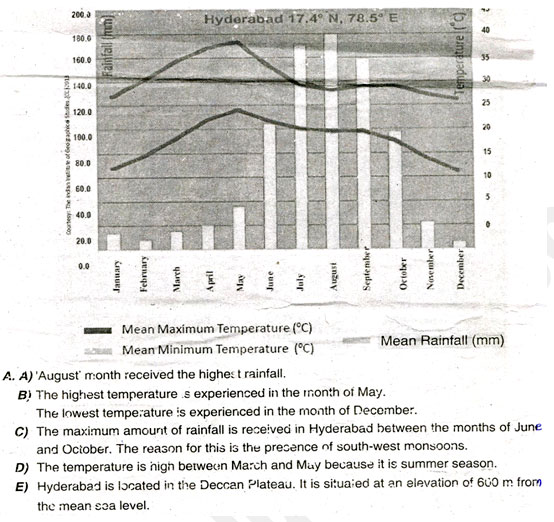Climate of India
Sakshi Education
 Key Points:
Key Points:
- The State of at morphemic Conditions over an area at a particular time refers to weather. Climate refers to such condition over a large area and follows a similar general pattern over many years.
- Climographs show average monthly values of maximum temperature minimum temperature, and rainfall for a given place.
- As we move away from the equator towards the poles, the average annual temperature decreases. In India the southern part lies in the tropical belt closer to the equator. Therefore, this region has higher average temperature than the northern part.
- A large part of southern India, because of its long coast line, comes under the moderating influence of the sea. Several hill stations of the Himalayan region have a cool climate even during the peak summer months.
- India lies in the belt of dry north-east trade winds. The climate of India is also affected by the movement of upper air currents known as ‘Jet streams’.
- Cyclone depressions coming from Mediterranean Sea called Western Disturbances cause low to moderate rainfall over northern India.
- The northern plain experiences dry and hot winds called ‘Loo’ towards the end of summer season; pre-monsoon showers are common in the Deccan plateau. They are locally known as mango showers.
- The monsoon forms in the tropical area approximately between 200N and 200S latitudes. The bulk of the annual rainfall in India is received from the South West Monsoon.
- The atmosphere traps a lot of the solar energy that reaches Earth by preventing it from totally escaping back to space. This is called Global Warming.
- Global Warming is causing many changes in the distribution of heat in the Earth system. One of the human activities that contributes to global warming is deforestation.
Key Words:
- Climograph: It shows averages monthly values of maximum temperature and minimum temperature, and rainfall for a given place.
- Weather: The state of the atmosphere at a given time and place respect to variables such as temperature, moisture, wind velocity and air pressure.
- Monsoon: The climate of India is strongly influenced by the monsoon winds. The regular periodic reversals of winds that blow towards the Indian coast are monsoons. Arab traders named this seasonal reversal of wind system as Monsoon.
- Insolation: It is the total amount of solar radiation energy received on a given surface area during a given time.
- Jet Streams: The climate of India is affected by the movement of upper air currents knows as ‘Jet streams’. These are fast flowing air currents in a narrow belt in the upper atmosphere, above 12,000m. A Jet stream causes the neighbouring atmosphere to cool and causes rain.
- Pressure Zone: The exertion of force by one body on the surface of another.
- Global Warming: An Unequal and continuing rise in the average temperatures of the Earth. As global temperature increases, the ice in the Tundra melts more. The methane that is trapped under the ice escapes in to the atmosphere, increasing the global temperatures. One of the human activities that contributes to global warming is deforestation.
Essay Type Questions
1. Describe India’s climate controls.
1. The factors that affect climate are called climatic controls. These include.
a) Latitude
b) Land – Water Relationship
c) Relief
d) Upper Atmospheric Circulation.
I. Latitude or Distance from the Equator:
The average temperature for the year drops as you go away from the equator. Intensity of temperature depends on the latitude. As we move away from the equator towards the poles, the average annual temperature decreases. In India, the southern part lies in the tropical belt closer to the equator. Therefore, this region has higher average temperature than the northern part. The part south of the tropic of cancer lies in the tropical zone. The part north of the Tropic of cancer lies in the temperate zone.
II. Land-Water Relationship:
A large part of southern India, because of its long coast line, comes under moderate influence of the sea. The difference between the temperature of day and night and that of summer and winter is not much. This is known as equable climate.
III. Relief:
The temperature decreases as altitude increases. Hence, hills and mountains will have lower temperature than location on the plain. Several hill stations of the Himalayan region have cool climate even during the peak summer months due to this factor.
IV Upper Atmospheric Circulation:
India lies in the belt of dry north-east trade winds. The climate of India is affected by the movement of upper air currents known as ‘Jet streams’. A jet stream cools the neighboring atmosphere. This cooling effect of the easterly Jet stream causes rains from clouds already hover over 250North latitude.
2. How are human activities contributing to global warming?
1. Describe India’s climate controls.
1. The factors that affect climate are called climatic controls. These include.
a) Latitude
b) Land – Water Relationship
c) Relief
d) Upper Atmospheric Circulation.
I. Latitude or Distance from the Equator:
The average temperature for the year drops as you go away from the equator. Intensity of temperature depends on the latitude. As we move away from the equator towards the poles, the average annual temperature decreases. In India, the southern part lies in the tropical belt closer to the equator. Therefore, this region has higher average temperature than the northern part. The part south of the tropic of cancer lies in the tropical zone. The part north of the Tropic of cancer lies in the temperate zone.
II. Land-Water Relationship:
A large part of southern India, because of its long coast line, comes under moderate influence of the sea. The difference between the temperature of day and night and that of summer and winter is not much. This is known as equable climate.
III. Relief:
The temperature decreases as altitude increases. Hence, hills and mountains will have lower temperature than location on the plain. Several hill stations of the Himalayan region have cool climate even during the peak summer months due to this factor.
IV Upper Atmospheric Circulation:
India lies in the belt of dry north-east trade winds. The climate of India is affected by the movement of upper air currents known as ‘Jet streams’. A jet stream cools the neighboring atmosphere. This cooling effect of the easterly Jet stream causes rains from clouds already hover over 250North latitude.
2. How are human activities contributing to global warming?
- The Earth has undergone several cycles of warming and cooling. Earlier cycles of this happened over very long periods of time. The huge time spans allowed much of the life on Earth to adapt to the changing climatic conditions. The problem with present cycle is the speed of heating is much rapid and could result in catastrophic changes. That’s why the present cycle is called Anthropogenic Global Warming (AGW), which literally means human generated global warming.
- Much of the global warming that has been occurring since the Industrial Revolution is because of human activities, unlike in the previous cycles.
- Human activities are negatively contributing to climate change by causing changes in Earth’s atmosphere due to heavy release of greenhouse gases. The largest known contribution comes from the burning of fossil fuels which releases carbon dioxide gas into the atmosphere.
- When we extract and burn fossil fuels such as coal or petroleum, we cause the release of Co2 and other heat-trapping ‘green house gases’ into the atmosphere.
- Large scale demolition of forests is also abetting the raise of Co2 levels in the atmosphere. Worldwide deforestation means we do not have as many trees as we need to absorb the extra Co2 . This means more Co2 stays in the atmosphere and traps more heat.
- A report issued by the IPCC stated that it is ‘virtually certain’ that emissions of carbon dioxide due to fossil fuel burning is the main cause of increasing atmospheric carbon dioxide during the 21st century.
- Activities related to agriculture such as fertilizing crops, storing waste in landfills, raising livestock are resulting in emissions of green house gases and speeding up the process of global warming. Emissions of small particles, known as aerosols, into the air can also lead to refection or absorption of the Sun’s energy.
- Climate change affects our environment and natural resources, and impacts our way of life in many ways. The more green-house gases we emit, the faster the climate change will be and more devastating our future will become.
3. How is climate change causing global warming? Suggest measures to minimize the influence of the global warming?
- Today’s problem is global warming is happening at a much rapid pace and could lead to catastrophic climatic changes across the globe. Much of the warming that has been occurring since the Industrial Revolution is man-made.
- As global temperature increases, the ice in the Tundra melts faster. The methane that is trapped under the polar ice escapes into the atmosphere, increasing the global temperatures. In turn, this causes even more ice to melt, releasing even more methane, and so on. Methane is said to be even more powerful than Carbon dioxide as a greenhouse gas.
- To minimize the influence of the global warming. We should plan to reduce the emissions of green-house gases. We should take up afforestation and encourage public transport systems.
- Some green tips that minimise the global warming are:
- Unplug all electrical devices completely when not in use.
- Swift to energy-efficient LED bulbs.
- Regulate room temperature. Keep the refrigerator’s temperature between 36-38 degrees’ F.
- Use Micro waves. Clean air conditioners filters regularly.
- Dry cloths on clothesline instead of a dryer.
- Ensure all taps are leak-free.
- Install dud –flush toilets to minimize water wastage.
- Reduce air- travel considerably.
- Use rechargeable batteries.
- Buy in bulk to reduce frequent trips to the super markets.
- Establish alternative power generators to avoid burning Fossil fuels.
- Afforestation should be taken up.
Short Answer type Questions
1. Write a short note on factors influencing climatic variation in hilly areas and deserts?
- Generally temperature decreases as altitude increases. Hills and mountains have lower temperature than plain areas. Relief of an area influences the climate.
- Several hill stations of Himalayan region have cool climate even during the peak summer months due to this factor. Similarly Kodaikanal and Ooty have cooler climate, compared to places near the coast, because of their altitude.
- As the Aravallis stop wind passages the Arabian Sea, the summer monsoons will not able to enter into Rajasthan. Aravallis for ‘rain shadow area’ on their western part in Rajasthan, which means the summer monsoons from Arabian Sea will not cross the mountain range. This makes about 50 per cent Rajasthan go dry. This how the deserts are formed. The rainfalls in this region are scanty and temperatures are very high.
2. What are the disagreements between ‘developed’ and ‘developing’ countries about AGW?
- Due to burning of fossil fuels, greenhouse gases are released into the atmosphere. Developed countries want developing countries to cut down the emissions of green house gasses.
- Developing countries argue that their economic development will be seriously damaged if they do not burn fossil fuels. Developing countries insist that developed countries should take their fair share to help find alternatives that can help them to progress.
3. Read the following statements and means if it is an example of weather or climate.
a. During the last few decade, many glaciers have melted in Himalaya.
Ans: Climate
b. During the last few decades drought in Vidarbha region has increased.
Ans: Climate
4. Match the following.
a). Trivandrum:
(i) Is further from the equator and temperature would be lower in the Winter.
b). Gangtok:
(ii) Is closer to the equator but not close to the seas and has low Rainfall.
c). Anantapur:
(iii) Is closer to equator, and climate has big impact of seas.
Answers: a) iii, b) i, c) ii.
5. Observe the following Climograph and answer the following questions.
a. During the last few decade, many glaciers have melted in Himalaya.
Ans: Climate
b. During the last few decades drought in Vidarbha region has increased.
Ans: Climate
4. Match the following.
a). Trivandrum:
(i) Is further from the equator and temperature would be lower in the Winter.
b). Gangtok:
(ii) Is closer to the equator but not close to the seas and has low Rainfall.
c). Anantapur:
(iii) Is closer to equator, and climate has big impact of seas.
Answers: a) iii, b) i, c) ii.
5. Observe the following Climograph and answer the following questions.
- Which month receives highest rainfall?
- Which months experience highest and lowest temperatures?
- Why the maximum amount of rainfall is between June and October?
- Why the temperature is high between March and May?
- Identity relief conditions causing variation in temperature and rainfall.

Published date : 10 Nov 2023 12:12PM















